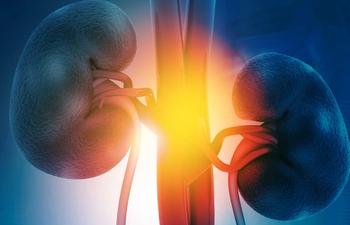
- ONCOLOGY Vol 36, Issue 1
- Volume 36
- Issue 2
- Pages: 30-31
Cisplatin Neoadjuvant Chemotherapy in an Aging Population With Muscle-Invasive Bladder Cancer
Jun Gong, MD, gives his perspective on neoadjuvant chemotherapy in elderly patients with muscle-invasive bladder cancer.
The authors of
The takeaway message from this study is that older age should not in itself preclude the offering of NAC in those with MIBC planned for RC. This point is of increasing clinical relevance in the modern treatment of MIBC. Bladder cancer is increasingly a diagnosis of the older patient, with a median age of diagnosis in the United States of 73 years and a median age of death of 79 years.1 The investigators therefore present findings that add to the literature, underscoring that NAC in properly selected elderly patients does not result in increased surgical morbidity with RC for MIBC. This is in keeping with other smaller studies whereby oncologic outcomes in younger vs older patients receiving NAC prior to RC were not statistically different. There were similar rates of nephrotoxicity, bone marrow suppression, and thromboembolic events across groups, and older patients did not require dose reduction more often than younger patients.2
These findings should be taken in the context that cisplatin-based chemotherapy remains the preferred regimen for NAC in MIBC; no data support the recommendation for perioperative chemotherapy in patients who are not candidates for cisplatin.3 As such, the evaluation of a patient’s candidacy for cisplatin is central to the overall evaluation for NAC in MIBC. Here, we have utilized classical criteria to determine a patient’s fitness for cisplatin,4 and in an aging population, in whom renal function normally declines with age, the classical threshold of calculated or measured creatinine clearance—under 60 mL/min—for determining cisplatin eligibility frequently comes into play.
Results of a 2006 analysis showed that of 208 patients receiving cisplatin-based chemotherapy for metastatic bladder cancer, 16% had a measured creatinine clearance less than 60 mL/min, while 12% to 44% of the same cohort had a calculated creatinine clearance less than 60 mL/min.5 Formulas for calculating creatinine clearance (Cockcroft-Gault, Jeliffe, Modification of Diet in Renal Disease, etc) were more likely than a measured creatinine clearance to misclassify a patient aged more than 65 years as ineligible for cisplatin-based chemotherapy. Whereas only 17 of 208 (22%) had measured creatinine clearance less than 60 mL/min, the proportion with a calculated creatinine clearance less than 60 mL/min ranged from 11% to 56% in this older age group. Therefore, although the data were extrapolated from a metastatic bladder cancer cohort, the methodology for determining creatinine clearance is concerning, and it should prompt further study and validation, particularly in the subgroup of patients greater than age 65 years.
In the real-world clinical management of elderly patients with MIBC and borderline renal function, clinical judgment and an informed decision-making process with the patient and family are key in deciding candidacy for cisplatin-based NAC. Notably, of the original consensus panel for the Galsky criteria, 33.8% of panel members voted for under 50 mL/min as the lower limit to define cisplatin ineligibility; this was slightly less than the 41.5% who voted for under 60 mL/min, which has come to be recognized as the standard creatinine clearance cutoff.4 The third most common vote, with 18.5%, was for the recommended creatinine clearance cutoff to be under 45 mL/min. More recent phase 3 trials of NAC in MIBC have also recognized a looser definition for cisplatin ineligibility and have recommended using creatinine clearance under 50 mL/min as the threshold (NCT03775265). In patients with borderline renal function, it should be noted that split-dose cisplatin (such as 35 mg/m2 on days 1 and 2 or days 1 and 8 of a 21-day cycle) may be reasonable in patients who may not optimally tolerate conventional cisplatin.3 In fact, in a recent series of patients who received neoadjuvant cisplatin and gemcitabine for MIBC, a substantial majority received split-dose cisplatin and gemcitabine (n = 112; 72.7%) with cisplatin given weekly for 2 of every 3 weeks at 35 mg/m2 per dose.6
Therefore, in the older patient with MIBC, age alone should not be the sole decision-making factor for cisplatin-based NAC. Although further study into the optimal measure of creatinine clearance in the elderly population is warranted, looser cutoffs of creatinine clearance for defining cisplatin ineligibility (eg, 40-60 mL/min) could allow a greater number of elderly patients with MIBC to receive NAC and RC while preserving the best chance for survival. This evaluation should be done in the context of a comprehensive assessment of a patient’s well-being and fitness for NAC. As the authors of this study rightfully proclaim, a formal geriatrics consultation or the completion of a Comprehensive Geriatric Assessment could also help in predicting postoperative and chemotherapy-related morbidity. Lastly, in patients with borderline renal function or performance status for conventional cisplatin, split-dose cisplatin NAC has growing evidence to support its use and could provide another opportunity to offer the survival benefits conferred by NAC prior to RC.
References
1. Galsky MD. How I treat bladder cancer in elderly patients. J Geriatr Oncol. 2015;6(1):1-7. doi:10.1016/j.jgo.2014.11.006
2. Leone AR, Zargar-Shoshtari K, Diorio GJ, et al. Neoadjuvant chemotherapy in elderly patients with bladder cancer: oncologic outcomes from a single institution experience. Clin Genitourin Cancer. 2017;15(4):e583-e589. doi:10.1016/j.clgc.2017.01.014
3. NCCN. Clinical Practice Guidelines in Oncology. Bladder cancer, version 5.2021. Accessed December 7, 2021. https://www.nccn.org/professionals/physician_gls/pdf/bladder.pdf
4. Galsky MD, Hahn NM, Rosenberg JE, et al; Cisplatin Ineligibility in Bladder Cancer Working Group. Defining “cisplatin ineligible” patients with metastatic bladder cancer. J Clin Oncol. 2011;29(suppl 7):abstr 238. doi:10.1200/jco.2011.29.7_suppl.238
5. Raj GV, Iasonos A, Herr H, Donat SM. Formulas calculating creatinine clearance are inadequate for determining eligibility for cisplatin-based chemotherapy in bladder cancer. J Clin Oncol. 2006;24(19):3095-3100. doi:10.1200/JCO.2005.04.3091
6. Iyer G, Tully CM, Zabor EC, et al. Neoadjuvant gemcitabine-cisplatin plus radical cystectomy-pelvic lymph node dissection for muscle-invasive bladder cancer: a 12-year experience. Clin Genitourin Cancer. 2020;18(5):387-394. doi:10.1016/j.clgc.2020.02.014
Articles in this issue
over 3 years ago
Looking Ahead: What’s Next for Hematology/Oncology in 2022?almost 4 years ago
Current Frontline Treatment of Diffuse Large B-Cell Lymphomaalmost 4 years ago
Reviewed in ONCOLOGY®: Gender Representation on Guideline PanelsNewsletter
Stay up to date on recent advances in the multidisciplinary approach to cancer.


















































































